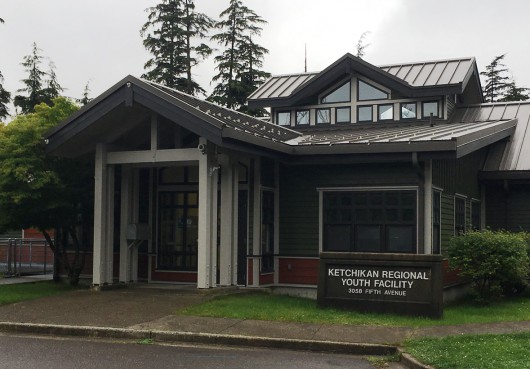
The Ketchikan Regional Youth Facility will close Sept. 15th due to state budget cuts. (File photo by Leila Kheiry)
The Ketchikan City Council decided Thursday to try selling the former Ketchikan Regional Youth Facility without setting a minimum bid.
The state closed the youth detention center in fall of 2016. The property reverted back to the City of Ketchikan, and has been vacant. The city tried selling it for its appraised value of about $1.4 million, but there were no bids.
Agnes Moran of Women in Safe Homes spoke to the council about the facility. She said her organization is interested in the building as a possible transitional housing service. But, she said, there are some big obstacles.
“A) The cost of renovating it are very, very high because it’s such a secure facility and B) the cost of operating it in its current configuration also is high,” she said. “If you look at the numbers from 2015, the utilities on that building for water, electric and heat was $37,000, which is pretty much beyond the scope of any nonprofit to run it in its current configuration.”
Part of that expense is because of the large-diameter water pipe, which Moran said puts the facility in a more expensive water-rate classification. But, she said, if the building is renovated or somehow made more affordable, it could be useful.
Moran said WISH and First City Homeless Services have applied for a grant for transitional housing funds.
During council discussion of the issue, Council Member Mark Flora spoke in favor of selling it as soon as possible. He said the building is a special-use institutional facility with no real market appeal.
“So, we’re gonna keep pumping money into heat and electricity while it slowly falls down,” he said. “And if we don’t do something pretty soon, we’re gonna wake up in five years and have something that’s worth nothing.”
Council Member Bob Sivertsen agreed, and suggested choosing an option of selling the facility without a minimum bid. But, the council has the power to reject any bids.
The council didn’t vote on the issue, but gave direction for management to move forward with that, and bring something back for the council.
Also on Thursday, the council approved three ordinances in first reading that will increase utility rates. This year’s budget is based on rate increases of 6 percent for wastewater, 5 percent for electricity, and 5.5 percent for water. Seafood processor water rates are to go up 35 percent.
The ordinances will come back for a second reading. Port and Harbors Director Steve Corporon told the council that water rates for cruise ships also will go up, by 20 percent.





